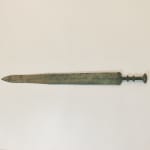Iron Age Judaean Short Sword (Dirk), First Millennium BC
Bronze
55.5 x 5 x 4 cm
21 7/8 x 2 x 1 5/8 in
21 7/8 x 2 x 1 5/8 in
CC.78
Further images
The Iron Age was a period of significant change in the Levant. It was in the Iron Age that we first get populations that define themselves as ‘Israelite’ as distinct...
The Iron Age was a period of significant change in the Levant. It was in the Iron Age that we first get populations that define themselves as ‘Israelite’ as distinct from their neighbours, settling in the Judean highlands, and in the city of Jerusalem. The population of the region nearly doubled, and there was a significant growth in agricultural and industrial production. People from across the region converged on Judea as a hub for trade, since it was strategically located on the crossroads between Europe, Africa and Asia. But the region was not entirely stable, and the many city-states of the Levantine region were often at war with one another. As a result, there are a large number of battle sites in the area and weapons of the period are a common archaeological find.
This short sword follows the basic Judean pattern, consisting of a pommel to counterbalance the weight, a handle which would originally have been sheathed in wood, but is now bare, and a medium-length blade. The blade is largely straight until two thirds of the way down, when it begins a more severe taper to the point. This gives an indication of this weapon’s primary purpose: this was not a hacking or slashing weapon, but was rather intended for stabbing.
Weapons like these would have seen active service in the many battles which took place throughout this turbulent period. The Levant was, after all, a strategic bonus, and many of the empires that surrounded it – Egypt, Babylon, Assyria, Persia, the Hittites, the Skythians – would regularly seek to subdue it. We know from the Amarna Letters, a corpus of documents relating to the court of the legendary Egyptian Pharaoh Akhenaten, that the petty kings of the region regularly sought favour with one or the other empire, hoping to bring their vast resources to bear on the petty squabbles of their inter-city rivalries.
This short sword follows the basic Judean pattern, consisting of a pommel to counterbalance the weight, a handle which would originally have been sheathed in wood, but is now bare, and a medium-length blade. The blade is largely straight until two thirds of the way down, when it begins a more severe taper to the point. This gives an indication of this weapon’s primary purpose: this was not a hacking or slashing weapon, but was rather intended for stabbing.
Weapons like these would have seen active service in the many battles which took place throughout this turbulent period. The Levant was, after all, a strategic bonus, and many of the empires that surrounded it – Egypt, Babylon, Assyria, Persia, the Hittites, the Skythians – would regularly seek to subdue it. We know from the Amarna Letters, a corpus of documents relating to the court of the legendary Egyptian Pharaoh Akhenaten, that the petty kings of the region regularly sought favour with one or the other empire, hoping to bring their vast resources to bear on the petty squabbles of their inter-city rivalries.













